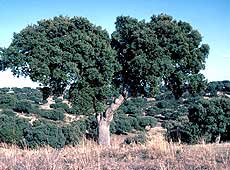Mediterranean Forests - Benefits to Society
Mediterranean forests represent one of the planet's important centres of plant diversity, with estimated 25,000 species of which around half are endemic. They also provide a wide range of important benefits and services to society that go far beyond traditional forest products.
The forests of the Mediterranean region are essential to maintaining water and soil resources. The forests protect watersheds and regulate the local climate by increasing the air humidity and thereby reducing the intensity of drought. In this way, they are a barrier against desertification. The forests also serve as natural barriers to storms and floods and they have considerable water retention capacity that reduces run-off and landslides during periods of heavy rain.

Forests have always played, and still play, an important role in the daily life of the Mediterranean peoples. People have been harvesting forest animal and plant products on a large scale in the region for thousands of years, developing numerous uses and management systems and acquiring sophisticated knowledge of their environment. In the past, forests and trees attributed long-standing cultural values that have defined the Mediterranean landscapes. Many endangered ecosystems and rare, endemic species in the Mediterranean still coexist in close relationship with humans.
Although Mediterranean forests provide low direct economic returns on wood products in comparison to the Northern European forests, they play a crucial role in maintaining key components for securing human welfare and life in the region. For instance, forests of the Northern Mediterranean region support tourism in a major way by providing recreation opportunities and scenic value. Given the significant differences in economic and social development across the region, the role of forests in society varies greatly between on one hand the Northern Mediterranean and the Eastern and Southern parts of the Mediterranean on the other.
Threats
to Mediterranean Forests
Previously,
exploitation of the natural
landscape was long, slow and
relatively sustainable. In the
past decades, that balance between
nature and humankind has been
lost. The forests are fragile
and under threat. Intensive
agricultural practices and climate
change threaten many of the
rare species that characterize
the Mediterranean region. Other
major causes of forest damage
in the Mediterranean include
fires, clearance and degradation
mainly due to ill-conceived
land use policies and development
pressure. Moreover, grazing
is still considered by many
to be a threat to the regeneration
of European Mediterranean forests,
yet it is also a factor that
maintains biodiversity richness
and diversity.

Although
considerable efforts have been
made to restore forest areas
in the Mediterranean, the tree
planting schemes used have often
failed to restore the range
of forest goods and services
necessary to maintain healthy
ecosystem integrity and to generate
socio-economic benefits for
local people. Decision-makers
and practitioners have to consider
how they can start to rebuild
forest assets for both people
and nature. Forest Landscape
Restoration (FLR) aims to do
exactly that.
Other
documents:
Arbovitae-Future
fires. Perpetuating problems
of the past.
WWF-IUCN
Global Review of Forest Fires.
UE
Recommendation on Forest Fires
in Southern Europe.
What
is Forest Landscape Restoration?
FLR is not a new idea. The approach builds on a number of existing rural development, conservation and natural resource management principles and approaches, bringing them together to restore multiple functions to degraded or deforested landscapes. It emphasizes the importance of both the quality and the quantity of tree cover and requires that ecological integrity is enhanced at the same time as tangible benefits accrue to local people. Although FLR seeks to build on the past, it does not aim to return forest landscapes to their original pristine forest state. Rather it is a forward-looking approach that puts in place forest-based assets that are good for both people and biodiversity.

Forest Landscape Restoration shifts the emphasis from purely re-establishing tree cover on a particular site to getting the right activities in the right place so that forest landscapes have the necessary mix of forest goods and services that can address socio-economic interests and secure biodiversity conservation. The objective is to promote and conserve multi-functionality across the entire landscape including agricultural land and both plantations and natural forests. Thus a small protected area may not be viable in isolation. But if nearby plantations are species rich or appropriate trees are planted in adjoining agricultural lands, the biodiversity of the area may survive.
Sustainable
forest restoration activities
can play a significant role
in meeting national commitments
in relation to a range of international
agreements and decisions. If
they are designed appropriately,
forest restoration activities
could contribute to the implementation
of the UNFF's Multi Year Programme
of Work (MYPOW), the convention
on Biological Diversity (CBD),
the UN Convention on Climate
Change (UNFCCC) and its Kyoto
Protocol and the Convention
to Combat Desertification (CCD).
Other
Documents:
Arbovitae
- Ecosystem approached and sustainable
forest management.
IUCN
- WWF Rehabilitation and Restoration
of Degraded Forests.
UNEP
- IUCN Carbon, Forests and People
(Click here for
Spanish
version)
For
further information, please
contact Rami
A. Salman. |